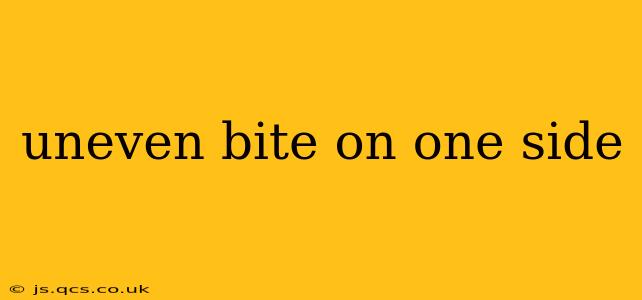An uneven bite, also known as malocclusion, is a common dental problem affecting many individuals. It occurs when the upper and lower teeth don't align correctly, leading to a mismatched bite on one or both sides of the mouth. This can cause various issues, from cosmetic concerns to more serious problems affecting your jaw joint and overall oral health. This comprehensive guide explores the causes, symptoms, and treatment options for an uneven bite, particularly focusing on the experience of having an uneven bite on just one side.
What Causes an Uneven Bite on One Side?
Several factors can contribute to an uneven bite, specifically affecting one side more than the other. These include:
- Genetics: Inherited traits can significantly influence jaw development and tooth alignment. A family history of malocclusion increases your risk of developing an uneven bite.
- Early Tooth Loss: Losing baby teeth prematurely or permanently losing adult teeth can disrupt the natural spacing and alignment of remaining teeth, leading to an uneven bite. The surrounding teeth can shift into the empty space, affecting the overall alignment.
- Thumb Sucking or Other Oral Habits: Prolonged habits like thumb sucking or excessive pacifier use, particularly past the age of 4, can exert significant pressure on developing teeth and jaws, resulting in misalignment.
- Trauma: Injuries to the mouth or jaw, such as falls or accidents, can affect tooth alignment and jaw structure, potentially leading to an uneven bite on one side.
- Oral Diseases: Conditions like periodontal disease, which causes gum inflammation and bone loss, can destabilize teeth, making them more prone to shifting and misalignment.
- Growth Disorders: Certain growth disorders can disrupt the normal development of the jaw bones, resulting in an uneven bite.
What are the Symptoms of an Uneven Bite on One Side?
Recognizing the symptoms of an uneven bite is crucial for early intervention. Symptoms may vary in severity but can include:
- Difficulty Chewing: An uneven bite can make it challenging to chew food efficiently, leading to discomfort or pain.
- Jaw Pain or TMJ Problems: The temporomandibular joint (TMJ), which connects your jaw to your skull, can be affected by an uneven bite, leading to pain, clicking, or popping sounds in the jaw.
- Facial Asymmetry: In some cases, an uneven bite can cause noticeable asymmetry in the face, with one side appearing different from the other.
- Speech Problems: Severe malocclusion can affect speech clarity, making it difficult to pronounce certain sounds.
- Headaches: The strain on the jaw muscles from an uneven bite can contribute to headaches, especially tension headaches.
- Excessive Wear on Teeth: Uneven bite pressure can cause excessive wear on certain teeth, leading to chipping or damage.
How is an Uneven Bite on One Side Diagnosed?
Diagnosing an uneven bite typically involves a thorough examination by a dentist or orthodontist. This may include:
- Visual Inspection: The dentist will visually inspect your teeth and jaw alignment to identify any irregularities.
- X-rays: X-rays help assess the underlying jaw structure and identify any bone abnormalities contributing to the misalignment.
- Dental Models: Impressions of your teeth are taken to create models that allow for a more detailed analysis of the bite.
What are the Treatment Options for an Uneven Bite on One Side?
Treatment options depend on the severity of the misalignment, the patient's age, and the underlying cause. Common treatments include:
- Braces: Traditional metal braces or clear aligners are often used to gradually reposition teeth and correct misalignment.
- Orthodontic Appliances: Various appliances, such as headgear or retainers, may be used in conjunction with braces to enhance treatment effectiveness.
- Dental Crowns or Veneers: In some cases, these may be used to restore the shape and size of damaged or worn teeth.
- Jaw Surgery (Orthognathic Surgery): For severe cases involving significant jaw bone misalignment, surgery may be necessary to correct the underlying structural problem.
How Long Does it Take to Treat an Uneven Bite?
Treatment duration varies considerably depending on the severity of the malocclusion and the chosen treatment method. Braces treatment can range from several months to a few years, while surgical interventions naturally take longer with additional recovery time.
Can an Uneven Bite Be Prevented?
While some causes of uneven bites are unavoidable, preventative measures can help minimize the risk:
- Maintaining Good Oral Hygiene: Regular brushing and flossing help prevent gum disease and tooth loss, crucial factors in maintaining proper tooth alignment.
- Avoiding Harmful Oral Habits: Discouraging thumb sucking or pacifier use in young children can prevent potential misalignment.
- Regular Dental Checkups: Regular checkups allow for early detection and treatment of any dental problems that could contribute to an uneven bite.
This information is for general knowledge and does not constitute medical advice. It is crucial to consult with a qualified dental professional for diagnosis and treatment of an uneven bite or any related dental concerns. They can provide personalized recommendations based on your specific situation.
